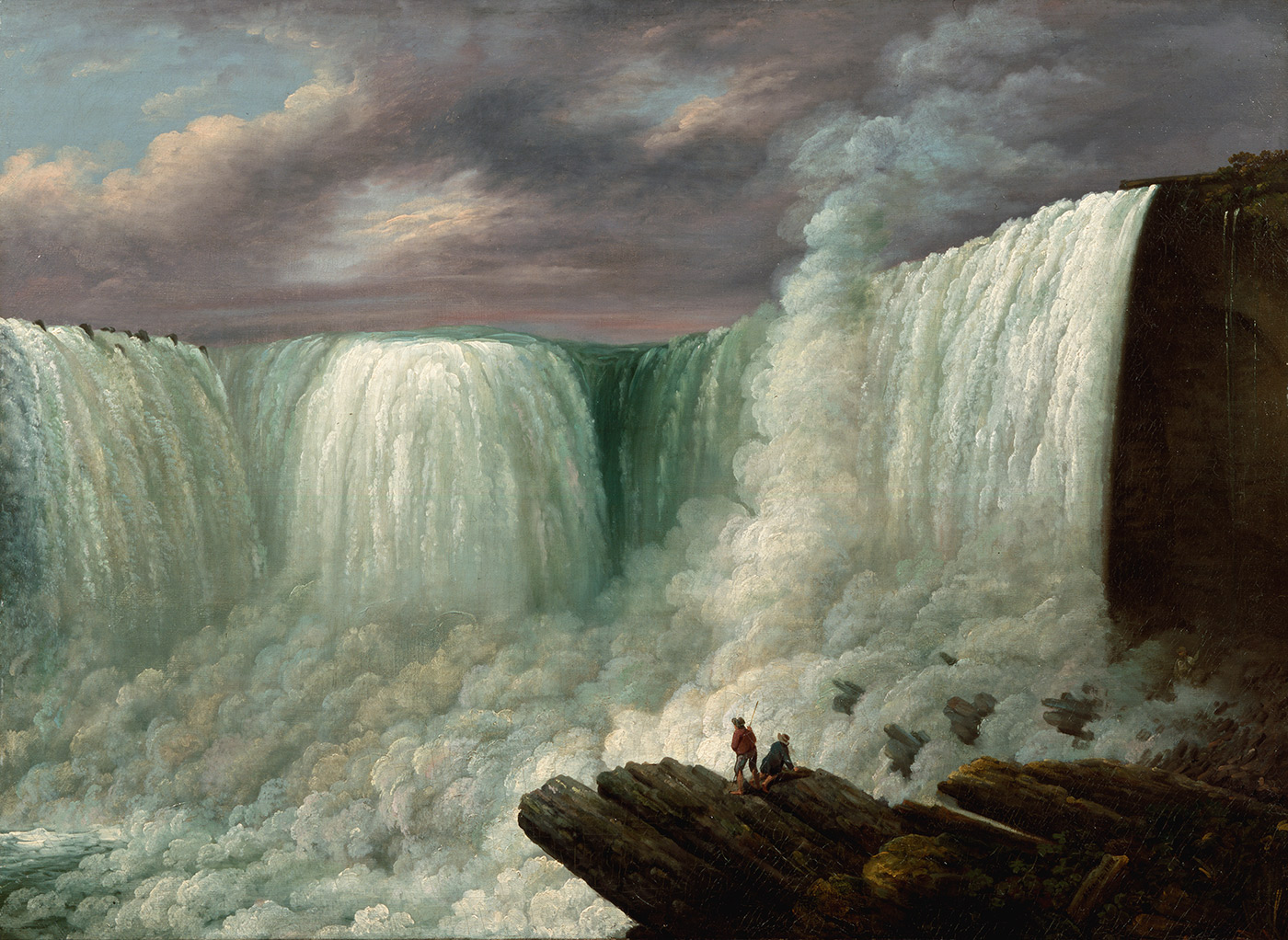The Poetry of Nature: A Golden Age of American Landscape Painting
On view from March 19 through June 12
Louisa Davis Minot (1788-1858). Niagara Falls, 1818. Oil on canvas, 30 x 40 5/8 in. Collection of the New-York Historical Society, Gift Mrs. Waldron Phoenix Belknap, Sr., to the Waldron Phoenix Belknap, Jr., Collection. 1956.3
A stunning array of over 40 paintings from the New-York Historical Society’s collection by renowned Hudson River School artists, including Thomas Cole, Asher Durand, Albert Bierstadt, Jasper Cropsey, John F. Kensett, and William T. Richards, will be on view for the first time at the Brandywine River Museum of Art from March 19 through June 12. Painted between 1818 and 1886, the works illustrate America’s scenic splendor as seen through the eyes of some of the country’s most important painters.
“The Hudson River School created some of the most beautiful paintings in American art. Their works forged a new vision for landscape painting and embodied the expansive and optimistic spirit of 19th- century America,” noted Thomas Padon, Director of the Brandywine River Museum of Art.
In the first decade of the 19th century, the expansive landscapes of the Hudson River Valley and adjacent areas, such as the Catskills and the Adirondack Mountains, inspired an elite group of American artists known as the Hudson River School. Coming together under the influence of British émigré painter Thomas Cole (1801–1848), they shared a philosophy and appreciation for the natural landscape. Today their collective works are considered the first uniquely American art movement. In their idyllic depictions of the landscape, these artists conveyed not only the majesty of America, but an image of man living in harmonious balance with nature.
The Poetry of Nature: A Golden Age of American Landscape Painting opens with seminal works by Thomas Cole and Asher B. Durand (1796–1886). The former artist first traveled up the Hudson in 1825. His tableaux capture the wildness of the American landscape. The latter frequently worked alongside Cole and was instrumental in leading the group after Cole’s untimely death in 1848. Cole’s romantic interpretations of the American landscape—represented in the exhibition by two paintings, one of a tranquil sunset view on the Catskill Creek and another of a sublime mountain landscape with jagged peaks piercing the clouds—demonstrate his mastery of perspective; he is able to convey vast open spaces and create rich atmospheric effects.
Durand favored tighter views and closely observed details of nature. Paintings in the exhibition will present his vivid compositions, from majestic mountain ranges to tranquil woodland interiors and studies of trees. Durand’s influential Letters on Landscape Painting (1855–1856), promoted the movement for plein air painting, calling such excursions, “hard-work-play.” As president of the National Academy of Design, he advocated for the landscape paintings by his Hudson River School colleagues at that institution and facilitated the patronage and rise of the Hudson River School.
Coinciding with an increase in leisure travel, the Hudson River painters also journeyed to regions noted for their beauty outside of New York State; New Hampshire, coastal New England, and even the Brandywine Valley were among the areas featured in their works. “The fact that some of these painters, such as William T. Richards and Jasper Cropsey, traveled to the Brandywine is a fascinating connection to this major American art movement. The exhibition helps put works by these artists and our outstanding collection of landscape paintings in broader context,” said Virginia O’ Hara, the Brandywine’s curator of collections & coordinator of curatorial affairs. “Their paintings of the Brandywine region’s verdant countryside, cool woodlands, and peaceful meandering streams fully embrace the spirit of the Hudson River School’s celebration of nature. It is a tremendously exciting opportunity to work with our esteemed colleagues at the New-York Historical Society to bring these inspiring icons of American landscape painting to our region.”
The exhibition has been organized by the New-York Historical Society, which features one of the most renowned collections of Hudson River School paintings. Dr. Linda S. Ferber, the director emerita of The New-York Historical Museum and a leading authority on Hudson River School artists, is the curator for this extraordinary exhibition. In conjunction with the exhibition, the Brandywine is organizing a wide array of public programs that will examine numerous aspects of this influential movement in American art with noted speakers drawn from across the country.
About the Brandywine River Museum of Art
The Brandywine River Museum of Art features an outstanding collection of American art housed in a 19th-century mill building with a dramatic steel and glass addition overlooking the banks of the Brandywine. The museum is open daily (except Thanksgiving Day and Christmas Day) from 9:30 a.m. to 5 p.m. Admission is $15 for adults, $10 for seniors ages 65 and over, $6 for students and children ages 6; free for children 5 and younger and Brandywine Conservancy & Museum of Art members. The museum is located on Route 1 in Chadds Ford, Pennsylvania. For more information, call 610.388.2700 or visit brandywinemuseum.org.
About the New-York Historical Society
The New-York Historical Society, one of America’s pre-eminent cultural institutions, is dedicated to fostering research and presenting history and art exhibitions and public programs that reveal the dynamism of history and its influence on the world of today. Founded in 1804, New-York Historical has a mission to explore the richly layered history of New York City and State and the country, and to serve as a national forum for the discussion of issues surrounding the making and meaning of history.